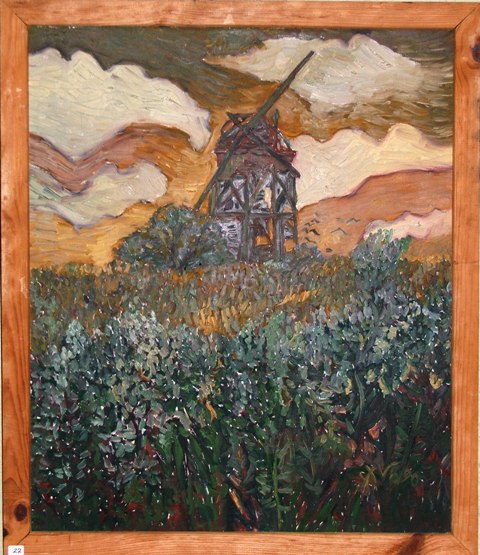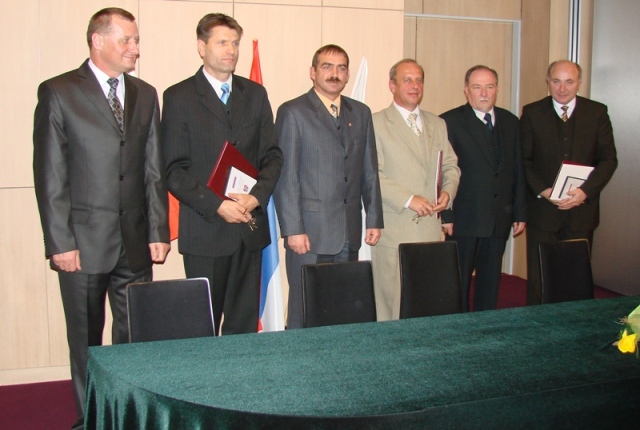Partners
Strzelce – Drezdenko County cooperates with two foreign partners – Havelland County (Germany), Aschersleben – Stassfurt County (Germany) and four national partners – Czarnków-Trzcianka County, Wałcz County, Gorzów County and the city of Gorzów Wlkp. Below you will find more information about partners and cooperation:
International cooperation of the Strzelce – Drezdenko County
Havelland County – Germany
Signing of the partner agreement - 25 January 2002.

Havelland County spreads between Berlin as the federal capital to the west and the border of Saxony-Anhalt state. Havelland is inhabited by 153 000 citizens living in 26 communes on the total area of 1.717 km2. The most densely populated city in the Havelland Country is Falkensee with about 37 000 inhabitants, then there is the county capital Rathenow with about 26 000 citizens. The country is divided into 26 communes, 5 towns without office buildings and 5 communes – there are 7 towns and 19 communes in total.
Havelland offers a unique combination of about 55 km of water, 430 km of forest and reserves with the area of 190km. Hawleć creates a beautiful surrounding. It also gave the region its name and exceptional character. The region owes its tranquillity to its rivers, lakes, meadows and forests. The quiet borderland villages invite tourists to relax and try various forms of active leisure surrounded by unspoilt nature. The Westhavelland Nature Part offers its visitors unique wildlife on the total area of 1300 km2. The lower Havel river valley is also a well-known European bird reserve.
In the Havelland County everyone will find something to their liking due to the region’s cultural diversity and ability to relax among nature.
Scope of cooperation and its effects:
To the extent of education:



- youth exchange:
- every year there are international camps in Scotland and Germany, where Germany, Scotland and Poland are their permanent participants, whereas countries such as Estonia, France, Cyprus and Greece participate only from time to time. Our partner, Havelland County, encouraged us to participate in this project. Camps, which take place in Germany are organized by the Havelland County and if the camp is located in Scotland, then Glasgow is the organizer – both cities are seats to the partner non-governmental organization.
Camps are also to be organized in Poland, in the Strzelce – Drezdenko County; - participation of youth from the Strzelce – Drezdenko County in the Sympathy Run organized every year in the Havelland County.
- library located in the Havelland County gave the library at the School Complex in Strzelce Kraj. books in German, which will help in learning the language;
To the extent of culture:



- cooperation of folk ensembles, Krajny from Strzelce with a dance ensemble from Rathenow.
- in 2005, in the period from September to November there was an exhibition of Polish artists from the Strzelce – Drezdenko County held in the Havelland County in Rathenow. It facilitated the official meeting of representatives of county authorities.
- from October to November 2006 there was an exhibition of German artists
from the Havelland County held in the Strzelce – Drezdenko County. It also facilitated the official meeting of representatives of county authorities. - in 2007 there were artistic workshops organized outdoor for Polish and German artists in one of the foregoing counties.
- in 2007 the Havelland County (representatives of local authorities, as well as the youth and artistic ensembles) participated in the cyclical event entitled “Meetings on the border”, organized together with the local partner – Czarnków-Trzcianka County.
To the extent of agriculture:

- visits and return visits of representatives of the Agricultural Chamber from the Strzelce – Drezdenko County with representatives of the County Farmers’ Organization from Havelland. There are two meetings during the year, one in Germany and one in Poland
To the extent of sports:
- joint sports competitions
- - Polish and German kayak camp in Długie in 2003.
To the extent of acquiring aid funds:
- Havelland County is a foreign partner to the Strzelce – Drezdenko County with reference to every investment or cultural project, which requires cross-border effects
To the extent of economy:
- participation in meetings with local businesses of representatives of the Strzelce – Drezdenko County in Havelland, and vice versa. Every year in the Havelland County there is a new year’s meeting with German business representatives, where representatives of the Strzelce – Drezdenko County also participate.
- in the the Strzelce – Drezdenko County in 2003 there was a meeting of representatives of the metallurgy industry from both partner counties, which resulted in the cooperation of 4 Polish-German companies, in the trade of raw materials and semi-finished products.
- in 2005 a meeting of companies in the wood industry was organized in the Strzelce – Drezdenko County, which hosted representatives from the wood industry from the Polish and German County, as well as representatives of local authorities from partner counties
To the extent of environmental protection:
- in 2005 cooperation between the Natural Park in Nabu –Havelland County and the League for the Preservation of Nature in Drezdenko was established
To the extent of international relations:
- in October 2006 during a solemn session of the Strzelce – Drezdenko County there was an exchange of flags of the partner counties: Strzelce – Drezdenko County and the Havelland County.
Cooperation with the Aschersleben – Stassfurt County, Germany was established in the year 2000
This cooperation focuses mainly on the exchange of youth between Stefaneum and Ascaneum Junior High Schools in Aschersleben and the Complex of Schools in Strzelce Kraj. and Dobiegniewo, as well as on the cooperation of school principals to exchange experiences and obtain mutual assistance.
National cooperation of the Strzelce – Drezdenko County


Powiat Czarnkowsko - Trzcianecki
www.czarnkowsko-trzcianecki.pl
The Czarnków-Trzcianka County situated in the northern part of the Greater Poland Voivodeship, is one of the few counties, which incorporates two, once independent cities, which alone were also independent counties. It is the second largest county in the Greater Poland with its area of 1808 km2 and ninth in terms of the number of citizens, which is about 88 000.
Important communication routes run through the Czarnków-Trzcianka County: from South to North, i.e. from Poznań to the Baltic Sea, as well as from West to East, i.e. Kostrzyn n/Odrą – Gorzów Wlkp. – Piła route. Furthermore, there is transit railway crossing the region, which runs through Krzyż Wlkp. – Trzcianka towards Piła and a more common route from Poznań to Szczecin.
In ancient times one of the branches of the Roman Amber Road crossed this region. The main river in the county is Noteć with its three bridges in Czarnków, Drawsko and Wieleń. In the villages of Ciszkowo and Walkowice there are ferry crossings open. The country incorporates 8 communes: One has a status of a municipality, i.e. Czarnków, which is also the sear of county authorities. There are three communes with an urban and rural status: Trzcianka, Krzyż Wlkp. and Wieleń, and four with the rural status: Czarnków, Drawsko, Lubasz and Połajewo.
Cooperation:
"Meetings on the border" – is a cycle of events being the result of the partnership agreement signed by the Strzelce – Drezdenko County, Czarnków-Trzcianka County and Wałcz County. Meetings started in 2004 in Drawsko. These events are organized every year in one of the counties. Traditionally on the first day of the meeting there is a conference with the participation of the distinguished visitors, which focuses on the partnering counties. On the second day there is a festival with children and youth from schools in both counties, as well as a concert of a famous celebrity. There are also sports and recreation activities, including a football game between members of the local government and county representatives.
Wałcz County
Wałcz County is located on the Wałcz Lakeland in the eastern part of the West Pomeranian Voivodeship, on the border of Greater Poland and Lubusz Voivodeships, in the lake district and in two geographic regions: Wałcz Lakeland and Wałcz Plain. There are five communes within the county: three communes with an urban and rural status: Człopa, Mirosławiec, Tuczno, one rural commune Wałcz and one urban commne: the town of Wałcz – a cultural centre and the starosty administrative seat. The total area is 1414,94 km2 and the number of citizens amounts to 54.851. Wałcz and its beautiful surroundings with numerous forests, lakes and picturesque landscapes preserved its natural character. There are multiple reserves in the region, e.g. "Wielki Bytyń" in the Mirosławiec, Tuczno and Wałcz counties with 247 types of plants, including 17 types of tress. The world of animals is incredibly rich here: there are boars, roe deer, deer, foxes, badgers, pine martens, weasels, otters, European bison, lesser spotted eagles and many more. There are also tourist trails: walking, bike tracks, waterways, sleeping accommodations, sports and entertainment facilities. The county’s development is mostly connected with tourism and agriculture.
Gorzów County


Gorzów County lies in Western Poland, in the Norther part of the Lubusz Voivodeship. On the North it borders with the Myślibórz County, on the East with Strzelce – Drezdenko and Międzyrzecz Counties, on the South with the Sulęcin and Słubice Counties, whereas on the West with Germany. The following are included in the Gorzów County: Kostrzyn nad Odrą, town and commune of Witnica and five urban communes: Bogdaniec, Deszczno, Kłodawa, Lubiszyn and Santok., which surround the city of Gorzów Wlkp. – the administrative capital of the voivodeship.
From the economic and environmental point of view the county’s location is extremely favourable. The road network is relatively dense and evenly distributed. National roads run from North to South (Świnoujście-Gorzów-Praga), as well as from West to East (Kostrzyn-Gorzów-Gdańsk). Regionak roads in the Gorzów County are quite evenly distributed. The transport network of district roads provides necessary connection between towns, which are county’s and commune’s seats, as well. They are complemented by a network of local roads.
Two waterways cross the Gorzów County:
- Oder river trail connecting the Silesia with Szczecin-Świnoujście port group,
- Warty and Noteć river trail connecting the waterways of Western Europe with Bydgoszcz and Gdańsk.
There are not many big factories in the region, apart from Arctic Paper Kostrzyn S.A. There are however many medium and small production, service and trade facilities, which are developing rapidly. Agriculture also shows a large potential, with its diversified agrarian structure and production profile.
City of Gorzów Wielkopolski
On 30 August 2014 in Strzelce Krajeńskie a partnership agreement was signed between the Czarnków-Trzcianka, Strzelce – Drezdenko, Wałcz and Gorzów Counties.

Gorzów is an idel city to live in – not too big, not too small, with good communication, quiet, peaceful and green. Gorzów citizens are the “Slavic Amercicans” – people with complicated life histories but open, hospitable and resourceful.
Gorzów citizens are just like the city – independent, willing to cross boundaries and aware that Gorzów has become a Safe Haven for people, who are not afraid to be themselves. And this tab is just for such people. It is the citizens that create this amazing atmosphere in Gorzów, they spend their lives here, use its services, participate in cultural and sports events, meet in clubs, pubs, restaurants, use public transport.
Safe Haven for Citizens was created for all, who are in any way connected with our city. Here you will find all necessary information about living in Gorzów. There is information about various tu eating places, the most important information about the city, practical advice about public transport, etc. You will also read about Gorzów schools and Municipal Police. If you are looking for information, which cannot be found here, feel free to contact us because this website is created for the citizens and we want them to have access to all information they require.